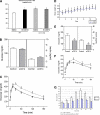CD14 modulates inflammation-driven insulin resistance
- PMID: 21700881
- PMCID: PMC3142089
- DOI: 10.2337/db10-1210
CD14 modulates inflammation-driven insulin resistance
Abstract
Objective: The study objective was to evaluate the possible role of the macrophage molecule CD14 in insulin resistance.
Research design and methods: The effects of recombinant human soluble CD14 (rh-sCD14) on insulin sensitivity (clamp procedure) and adipose tissue gene expression were evaluated in wild-type (WT) mice, high fat-fed mice, ob/ob mice, and CD14 knockout (KO) mice. We also studied WT mice grafted with bone marrow stem cells from WT donor mice and CD14 KO mice. Finally, CD14 was evaluated in human adipose tissue and during differentiation of human preadipocytes.
Results: rh-sCD14 led to increased insulin action in WT mice, high-fat-fed mice, and ob/ob mice, but not in CD14 KO mice, in parallel to a marked change in the expression of 3,479 genes in adipose tissue. The changes in gene families related to lipid metabolism were most remarkable. WT mice grafted with bone marrow stem cells from WT donor mice became insulin resistant after a high-fat diet. Conversely, WT mice grafted with cells from CD14 KO mice resisted the occurrence of insulin resistance in parallel to decreased mesenteric adipose tissue inflammatory gene expression. Glucose intolerance did not worsen in CD14 KO mice grafted with bone marrow stem cells from high fat-fed WT mice when compared with recipient KO mice grafted with cells from CD14 KO donor mice. CD14 gene expression was increased in whole adipose tissue and adipocytes from obese humans and further increased after tumor necrosis factor-α.
Conclusions: CD14 modulates adipose tissue inflammatory activity and insulin resistance.
Figures




References
-
- Pickup JC, Crook MA. Is type II diabetes mellitus a disease of the innate immune system? Diabetologia 1998;41:1241–1248 - PubMed
-
- Fernández-Real JM, Ricart W. Insulin resistance and chronic cardiovascular inflammatory syndrome. Endocr Rev 2003;24:278–301 - PubMed
-
- Fernández-Real JM, Broch M, Richart C, Vendrell J, López-Bermejo A, Ricart W. CD14 monocyte receptor, involved in the inflammatory cascade, and insulin sensitivity. J Clin Endocrinol Metab 2003;88:1780–1784 - PubMed
-
- Fernández-Real JM, Pickup JC. Innate immunity, insulin resistance and type 2 diabetes. Trends Endocrinol Metab 2008;19:10–16 - PubMed
Publication types
MeSH terms
Substances
LinkOut - more resources
Full Text Sources
Other Literature Sources
Molecular Biology Databases
Research Materials
Miscellaneous

